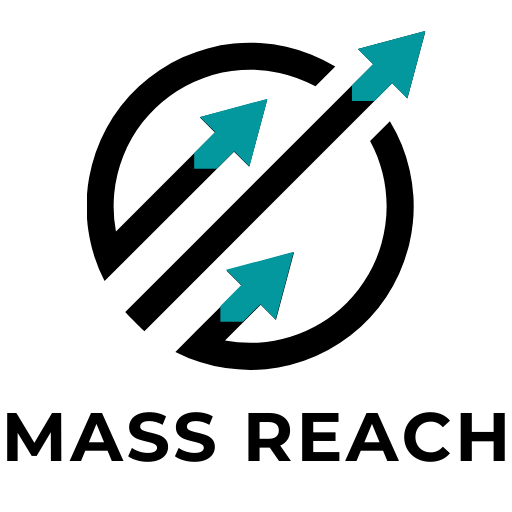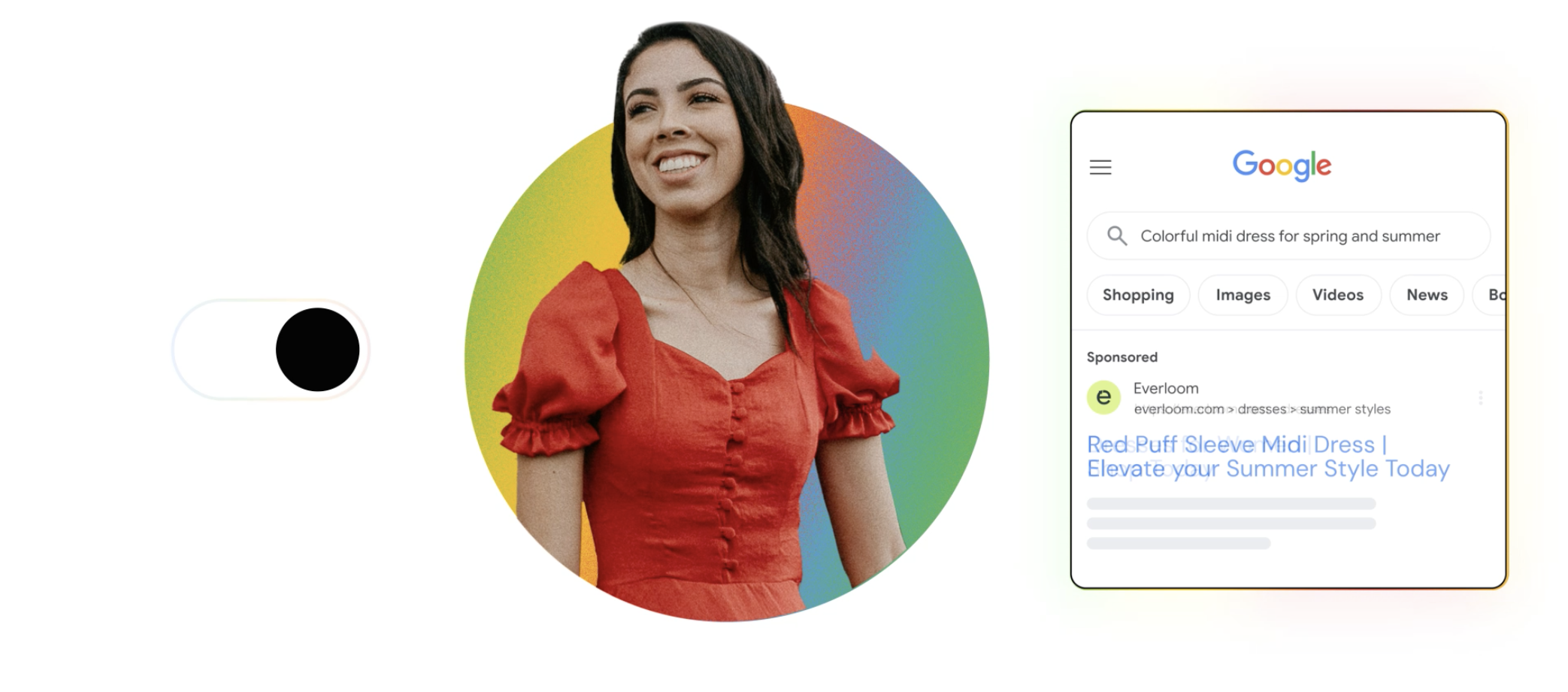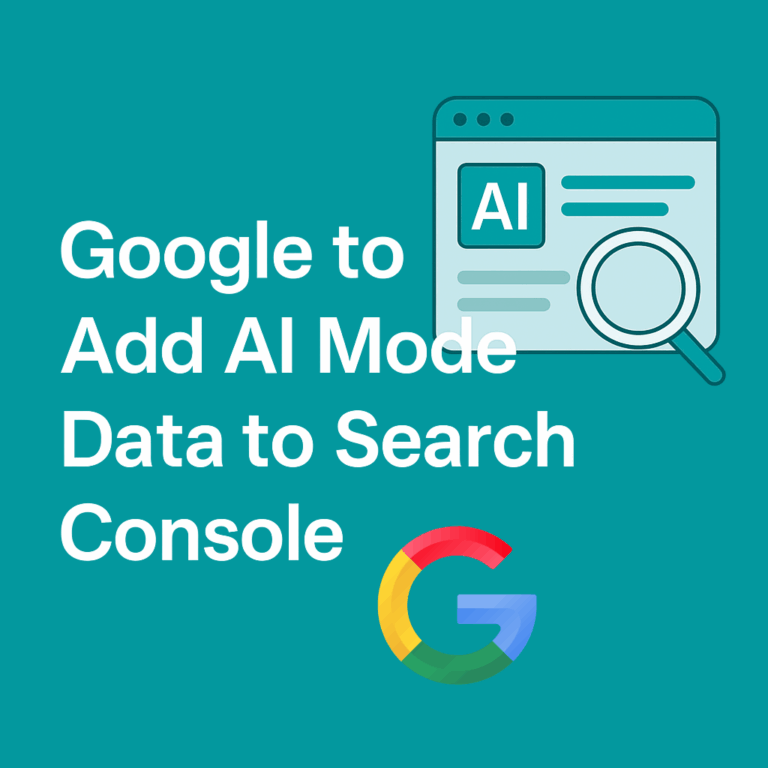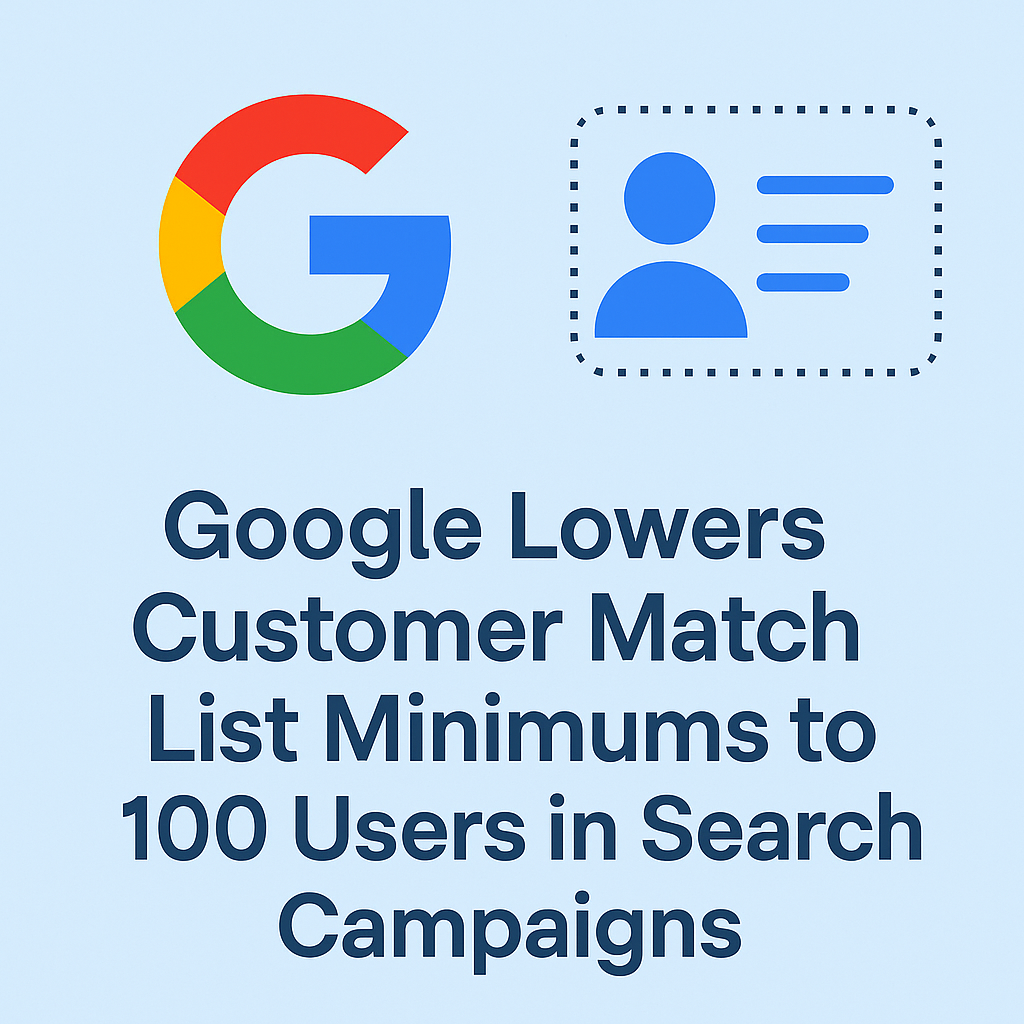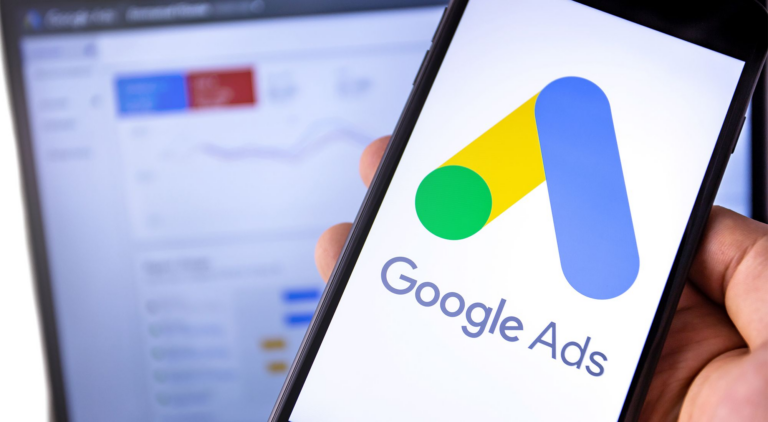Google’s advertising platform is rapidly evolving with AI-driven capabilities. The latest innovation for Search campaigns is AI Max, a comprehensive suite of targeting and creative enhancements that brings the best of Google AI to help take your Search campaigns to the next level. In this blog post, we’ll dive into what AI Max is, how it works and why it matters for small business owners looking to maximise their Google Ads performance.
What is AI Max for Search Campaigns?
AI Max for Search campaigns is essentially a one-click opt-in feature that integrates Google’s most advanced AI-powered targeting and creative tools directly into your standard Search campaigns. When you enable AI Max, Google Ads will automatically activate a bundle of features designed to expand your reach to untapped search queries and dynamically tailor your ad copy and landing pages – all powered by Google’s latest AI. In other words, AI Max helps you reach more relevant searches and create more relevant ads in real time, without having to manually add tons of keywords or write dozens of ad variations.
According to Google, AI Max offers “a faster way to expand on queries and dynamically create new ads and assets with one click.” Rolling out globally in beta (as of May 2025), it combines new and existing features – such as broad match expansion, keywordless targeting technology and generative AI for ad asset creation, under a single umbrella. This means advertisers can supercharge their Search campaigns with minimal effort: Google’s AI will learn from your campaign’s keywords, website content and existing ads to find additional high-performing search queries you might be missing and simultaneously generate tailored headlines and descriptions to match those queries.
In short, AI Max transforms a standard Search campaign into a smarter, more adaptive campaign, akin to how Performance Max operates but focused solely on Search. By enabling AI Max, you allow Google’s algorithms to dynamically match your ads to more searches and adapt your ad creative on the fly to better align with what users are looking for. And importantly, it does this while giving you new controls and transparency to ensure the AI works in your favour.
Key Features of AI Max (How it Works)
When you activate AI Max, several features kick in behind the scenes to enhance your campaign. Let’s break down the key components of AI Max and how each contributes to better performance:
- Search Term Matching: This feature uses broad match and keywordless AI technology to expand your reach beyond the exact keywords you’ve provided. Google’s AI will analyze your existing keywords, ads and landing page content to identify other relevant search queries that you didn’t explicitly bid on but are highly related to your business. Essentially, it’s an intelligent mix of traditional broad match and what was formerly known as Dynamic Search Ads, finding new opportunities based on user intent. This means your ads can show on relevant long-tail or related searches, capturing additional traffic and conversions you might otherwise miss. For example, if you sell fitness trackers and only bid on terms like “buy fitness tracker,” AI Max could match your ads to searches like “health monitoring wristband” or “activity tracker deals” even if those terms aren’t in your keyword list. You still retain control – for instance, you can use negative keywords to exclude any queries you know are irrelevant or unprofitable but overall, search term matching gives a powerful expansion of reach with Google’s AI predicting user intent.
- Text Customisation (AI-Generated Ad Copy): The text customisation setting (formerly known as Automatically Created Assets, ACA) uses content from your website, landing pages, existing ads and other provided assets, combined with Google’s generative AI, to create new ad assets (headlines and descriptions) tailored to each user’s query. In other words, Google can dynamically rewrite or assemble ad copy on the fly so that it better matches what the user is searching for. This results in more relevant ads without you having to manually write dozens of variations. For instance, if a user’s query mentions a specific product or problem that you address, AI might insert a headline or description highlighting that exact detail pulled from your site. Google has improved its ability to generate assets that include clear calls-to-action and unique selling points of your business. Text customisation brings the promise of responsive search ads (RSAs) to the next level, instead of just mixing and matching your provided text, it can create new text aligned to the query while still following your overall messaging. (Of course, this feature respects Google Ads policies and uses your domain’s content responsibly – it’s wise to keep your website up-to-date so the AI doesn’t grab outdated info.)
- Final URL Expansion (Dynamic Landing Pages): When final URL expansion is enabled, Google’s AI will send each user to the most relevant page on your website for their query, rather than a fixed landing page for all users. This is very similar to how Dynamic Search Ads choose landing pages based on the search term. With AI Max, if a different page on your site is likely to convert better for a particular search, the system can automatically use that URL for the ad’s destination. For example, a hardware store might generally send ad traffic to a generic “Tools” page, but if someone searches for a specific drill model that you have on a product page, final URL expansion can send that user directly to the exact product page. This feature helps match user intent with the right landing page, improving user experience and conversion chances. Important: Final URL expansion only works if text customisation is also turned on, because Google needs to generate ad copy that matches the content of whatever landing page it chooses. In AI Max, when you switch it on, both text customisation and final URL expansion are activated by default as a pair. (If you ever disable text customisation, final URL expansion will automatically disable too, since the two go hand-in-hand.)
- New Controls: Locations of Interest & Brand Settings: AI Max introduces additional controls to help you refine where and when your ads appear, giving you precision similar to traditional keyword targeting, but in new ways. One such control is Locations of Interest targeting. This allows you to target users based on their intent or interest in a location, not just their physical location. For example, if you run a local business in London, you can use location of interest targeting so that someone searching for “antique store in London” sees your ad even if they are physically in another city at the time. Previously, achieving this might require adding many location-related keywords or using complicated location settings but now it’s a simple toggle at the ad group level for AI Max campaigns. Another control is Brand Inclusions/Exclusions. You can specify certain brand names that you want your ads associated with (for instance, if you sell specific brands or are targeting co-branding opportunities), or exclude specific brands to prevent your ads from showing alongside those brand queries. This is useful for avoiding competitor searches or irrelevant brand contexts. These brand controls exist at both the campaign and ad group level in AI Max. In short, you get granular control to fine-tune the AI’s behaviour, something advertisers used keywords for in the past, now achievable with these new settings.
- Improved Reporting & Transparency: A common concern with automation is visibility, knowing why your ads showed and what content was used. Google addresses this in AI Max with enhanced reporting. In your Search Terms report, you’ll now see a new match type labeled “AI Max” for queries that were matched via these AI-driven expansions, along with a “source” column indicating if it was matched by broad match expansion or by keywordless (content-based) matching. Even more interesting, the search terms report will show the actual ad headlines and URLs that were served for each query, giving you a clear view of the customer’s journey from query to ad to landing page. Similarly, the Asset report in Google Ads now highlights performance metrics (like conversions, spend) for AI-generated assets, not just the ones you wrote. You even have an Asset Removals option: if the AI generates a particular headline or description that you don’t like or that isn’t performing, you can remove it and Google will stop using that asset in your ads. These reporting improvements mean that even though AI Max automates a lot, you’re not flying blind; you can monitor and tweak what the AI is doing.
In summary, AI Max turns on a suite of features that work together: it finds more queries to show your ads on, automatically writes ad text to match those queries, and chooses the best landing page for each user – all while giving you controls (like location intent and brand filters) and transparency (reports on what’s happening). It’s a holistic AI upgrade to your Search campaign.
Benefits of AI Max: Why Use It?
The promise of AI Max is better performance with less manual work. Early results from Google and beta testers are very encouraging. Google’s internal data shows that advertisers who activate AI Max in their Search campaigns see on average 14% more conversions (or conversion value) at a similar cost-per-acquisition or return on ad spend. If your campaign was previously focused on very tight keyword targeting (mostly exact and phrase match keywords), the uplift can be even higher – typically around 27% more conversions because AI Max can suddenly capture many valuable queries you weren’t targeting before. In other words, the more room for expansion your campaign had, the more AI Max can help drive new results.
Real-world examples illustrate these gains. For instance, L’Oréal – a global beauty brand – participated in the AI Max tests and reported a 2X higher conversion rate and 31% lower cost-per-conversion after enabling AI Max. How did AI Max achieve this? By finding net-new search queries that L’Oréal’s normal campaigns weren’t capturing, such as long-tail questions like “what is the best cream for facial dark spots?”. The AI identified that query as relevant and showed a tailored ad, bringing in a conversion that would have been missed otherwise.
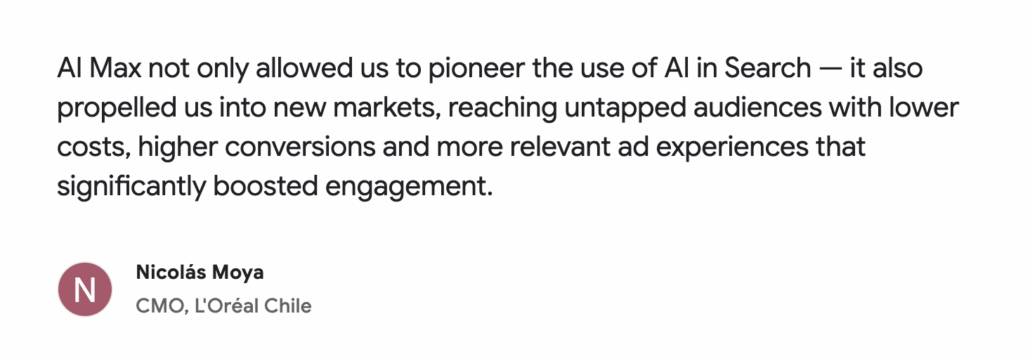
So why is AI Max delivering such results? The core benefit is that it leverages Google’s vast AI to do things no human team can do at scale or in real-time. Even a savvy marketer would struggle to anticipate every niche way a user might search for their product or to rewrite ad text on the fly for each of hundreds of queries. AI Max does this heavy lifting automatically. It ensures that if there is a relevant search out there, you have a chance to show up for it and if you show up, your ad will make sense to that user’s intent. This leads to more clicks and more conversions that you might have otherwise missed. At the same time, by matching users to the optimal landing page (via final URL expansion) and crafting ad messages aligned to their intent, AI Max likely improves the user experience; meaning higher conversion rates and better ROI on your ad spend.
Another benefit is time savings and simplicity. Small business owners often wear many hats and don’t have hours to spend on granular Google Ads management every day. AI Max can act as a force multiplier for your marketing: it’s like having a very knowledgeable assistant who keeps an eye out for new opportunities and optimises your ads continuously. One paid media expert noted that “AI Max helps go beyond traditional keyword strategies, dynamically customises ad creative in real time, increasing relevance and conversions without adding complexity.” For advertisers or agencies managing large accounts, it offers a low-effort way to scale results and stay competitive as search behaviour evolves. In plain terms, you get more out of your campaigns with less manual tweaking.
Of course, a technical audience might ask: what about control? Google has clearly learned from advertisers’ feedback on automation, AI Max includes those location and brand controls and the transparency in reporting as discussed, which help address the usual concerns about “black box” automation. You can see what queries were matched and what ads were shown and exclude things you don’t like. You can also still use all the normal levers like budgets, bids (typically you’d use a smart bidding strategy like Maximise Conversions or Target CPA/ROAS alongside AI Max) and negative keywords. In fact, using AI Max effectively might involve regular monitoring of the search terms report to add negatives for any off-target matches; thereby training the AI on what’s not relevant for your business. Google providing the new “AI Max” match type label in reports makes this easier because you can filter to see what the AI is bringing in.
In summary, the benefits of AI Max boil down to more reach, more relevance and more conversions all achieved through advanced AI automation while still maintaining control and insight. For a small business, this could translate to tangible growth in customers without needing an in-house PPC expert to micromanage campaigns daily.
How Mass Reach Can Help Optimise Your Google Ads (with AI Max)
Adopting new features like AI Max can be a game-changer for your marketing but it can also feel overwhelming to navigate at first. This is where Mass Reach comes in. As a marketing agency with deep expertise in Google Ads (and as marketing experts ourselves), we stay on the cutting edge of these innovations so you don’t have to. We’ve been following the rollout of AI Max closely and we’re already helping a number of clients globally to harness AI Max for better campaign performance.
to focus on other aspects of your business. With our expertise, we help you avoid the potential pitfalls of automation and accelerate straight to the positive results.
Ready to take your Google Ads to the next level? Whether you’re excited about the prospect of 14%+ more conversions or you simply want to ensure you’re not left behind as Google Ads evolves, Mass Reach is here to help. We’ve successfully managed campaigns for clients globally, implementing the latest features like AI Max to drive growth. Feel free to reach out to us for a consultation on how we can tailor these AI-powered tools to your marketing goals. Together, let’s harness the power of Google’s AI to maximise your campaign performance and keep your business ahead of the curve.

